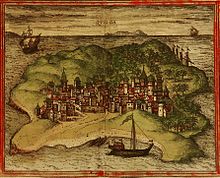History

A 1.8 million year-old stone chopping tool discovered at Olduvai Gorge and currently on display at the British Museum
Pre-colonial
The indigenous populations of eastern Africa are thought to be the click speaking Hadza and Sandawe hunter-gatherers of Tanzania.[17]:page 17The first wave of migration was by Southern Cushitic speakers who moved south from Ethiopia into Tanzania. They are ancestral to the Iraqw, Gorowa, and Burunge.[17]:page 17 Based on linguistic evidence, there may also have been two movements into Tanzania of Eastern Cushitic people at about 4,000 and 2,000 years ago, originating from north of Lake Turkana.[17]:pages 17–18
Archaeological evidence supports the conclusion that Southern Nilotes, including the Datoog, moved south from the present-day South Sudan / Ethiopia border region into central northern Tanzania between 2,900 and 2,400 years ago.[17]:page 18
These movements took place at approximately the same time as the settlement of the iron-making Mashariki Bantu from West Africa in the Lake Victoria and Lake Tanganyika areas. They brought with them the west African planting tradition and the primary staple of yams. They subsequently migrated out of these regions across the rest of Tanzania between 2,300 and 1,700 years ago.[17][18]
Eastern Nilotic peoples, including the Maasai, represent a more recent migration from present day South Sudan within the past 500 to 1,500 years.[17][26]
The people of Tanzania have been associated with the production of iron and steel. The Pare people were the main producers of highly demanded iron for peoples who occupied the mountain regions of north-eastern Tanzania.[27] The Haya people on the western shores of Lake Victoria invented a type of high-heat blast furnace, which allowed them to forge carbon steel at temperatures exceeding 1,820 °C (3,310 °F) more than 1,500 years ago.[28]
Travelers and merchants from the Persian Gulf and India have visited the east African coast since early in the first millennium A.D.[29] Islam was practiced by some on the Swahili Coast as early as the eighth or ninth century A.D.[30]
Colonial

A 1572 depiction of the city of Kilwa, a UNESCO World Heritage Site

Maji Maji Rebellion against German colonial rule in 1905
During World War II, about 100,000 people from Tanganyika joined the Allied forces[38] and were among the 375,000 Africans who fought with those forces.[39] Tanganyikans fought in units of the King's African Rifles during the East African Campaign in Somalia and Abyssinia against the Italians, in Madagascar against the Vichy French during the Madagascar Campaign, and in Burma against the Japanese during the Burma Campaign.[39] Tanganyika was an important source of food during this war, and its export income increased greatly compared to the pre-war years of the Great Depression[38] Wartime demand, however, caused increased commodity prices and massive inflation within the colony.[40]
In 1954, Julius Nyerere transformed an organisation into the politically oriented Tanganyika African National Union (TANU). TANU's main objective was to achieve national sovereignty for Tanganyika. A campaign to register new members was launched, and within a year, TANU had become the leading political organisation in the country. Nyerere became Minister of British-administered Tanganyika in 1960 and continued as prime minister when Tanganyika became independent in 1961.[citation needed]
Post-colonial
British rule came to an end on December 9, 1961, but for the first year of independence, Tanganyika had a governor general who represented the British monarch.[41]:page 6 On 9 December 1962, Tanganyika became a democratic republic under an executive president.[41]:page 6After the Zanzibar Revolution overthrew the Arab dynasty in neighbouring Zanzibar,[42] which had become independent in 1963, the archipelago merged with mainland Tanganyika on 26 April 1964.[43] On 29 October of the same year, the country was renamed the United Republic of Tanzania ("Tan" comes from Tanganyika and "Zan" from Zanzibar).[14] The union of the two hitherto separate regions was controversial among many Zanzibaris (even those sympathetic to the revolution) but was accepted by both the Nyerere government and the Revolutionary Government of Zanzibar owing to shared political values and goals.
Following Tanganyika's independence and unification with Zanzibar leading to the state of Tanzania, President Nyerere emphasized a need to construct a national identity for the citizens of the new country. To achieve this, Nyerere provided what is regarded as one of the most successful cases of ethnic repression and identity transformation in Africa.[44] With over 130 languages spoken within its territory, Tanzania is one of the most ethnically diverse countries in Africa. Despite this obstacle, ethnic divisions remained rare in Tanzania when compared to the rest of the continent, notably its immediate neighbor, Kenya. Furthermore, since its independence, Tanzania has displayed more political stability than most African countries, particularly due to Nyerere's ethnic repression methods.[45]
In 1967, Nyerere's first presidency took a turn to the left after the Arusha Declaration, which codified a commitment to socialism as well-as Pan-Africanism. After the declaration, banks and many large industries were nationalised.
Tanzania was also aligned with China, which from 1970 to 1975 financed and helped build the 1,860-kilometre-long (1,160 mi) TAZARA Railway from Dar es Salaam to Zambia.[46] Nonetheless, from the late 1970s, Tanzania's economy took a turn for the worse, in the context of an international economic crisis affecting both developed and developing economies.
From the mid-1980s, the regime financed itself by borrowing from the International Monetary Fund and underwent some reforms. Since then, Tanzania's gross domestic product per capita has grown and poverty has been reduced, according to a report by the World Bank.[47]
In 1992, the Constitution of Tanzania was amended to allow multiple political parties.[48] In Tanzania's first multi-party elections, held in 1995, the ruling Chama Cha Mapinduzi won 186 of the 232 elected seats in the National Assembly, and Benjamin Mkapa was elected as president.[49]








No comments:
Post a Comment